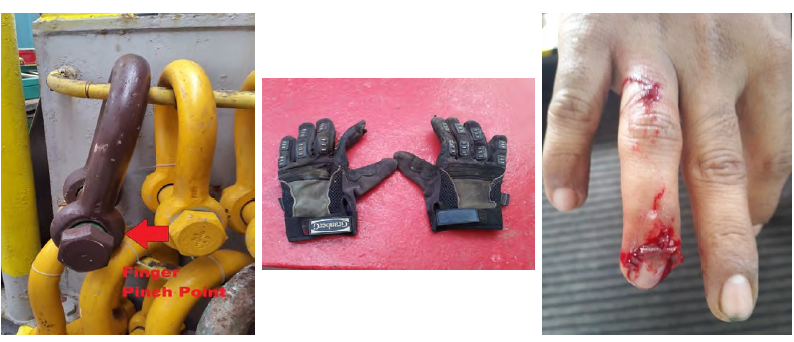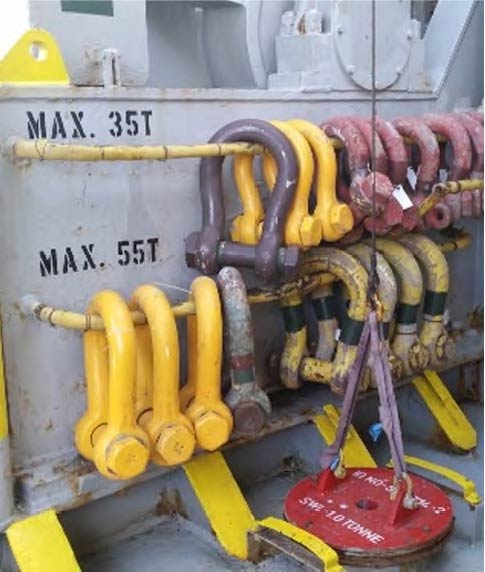Finger injury during maintenance work – restricted work case
A member has reported an incident in which a seaman suffered a serious finger injury whilst lifting and moving heavy shackles. The incident occurred whilst he was working on deck with the Bosun, colour-code painting of the shackles and moving the shackles on to the rack after the job had been completed. The injured person and the Bosun agreed that they would lift and replace the heavier shackles together, lowering them into positon before finally dropping them the last short distance – each person letting go ‘on the count of three’.
They lifted a large shackle, weighing 44kg, into position and the Bosun begun the count – on reaching 3, he let go but the injured person did not, causing his finger tip to become crushed between the dropped shackle and another shackle already on the rack below. He received first aid treatment on-board, but after examination by the platform medic, he was sent ashore for further medical treatment. He returned later that day and was assigned to restricted duties, with a minor fracture, bruising and cuts to his finger.



Our member’s investigation revealed the following:
Despite a very detailed and discussed control of work process, some major items were missed:
- The risk assessment was very detailed and included specific awareness on pinch points (following positive learning from a previous incident) and manual handling. However, no consideration was given to the use of additional, mechanical control measures – chain blocks, strops. – for handling heavier shackles
- A toolbox talk had been conducted and attended by everyone involved. However, despite the use of lifting equipment and manual handling being identified here, the work progressed without the necessary equipment and control measures in place
- Despite the difficulties experienced in lifting the heavier shackles, no-one exercised the stop work policy. The Bosun and the injured person came up with an unplanned – and hazardous – solution, rather than stopping and re-assessing how the work could have been completed in a safer manner, using a dedicated safe lifting arrangement.
Our member took the following actions:
- The injured person received immediate first aid on-board and was then sent ashore to hospital for medical treatment;
- An on-board ‘Time Out for Safety’ was held to discuss the incident and failings, and to discuss corrective actions;
- The crew implemented corrective and preventative measures (see the photographs above);
- Changes were made to the safety management system documentation to enhance coverage of manual handling and pinch points.
Our member identified some important lessons:
- Learn from previous mistakes – ensure that lessons learnt from other incidents are applied to your daily working duties, to make your tasks safer;
- Toolbox talks are not one-way conversations, but an opportunity for ALL team members to speak up and ask questions, discuss the task, ensure all control measures are in place and that everyone is clear on their duties and responsibilities during the job;
- Ensure all Control of Work requirements are in place – before starting the job, ensure that every safety and control measure required by the risk assessment, permit to work and toolbox talk is in place and is correct. If something is missing, or not implemented correctly – or even if you have some concerns about the measures that are in place – do not start the job until everything is in place and correct;
- Do not use unplanned work practices – exercise the stop work policy if you need to, but step back and reassess the task to find a safer, easier alternative.
Injuries resulting from fingers and/or hands being crushed or caught between something, are a recurring theme in IMCA safety flashes. members may wish to look at the following incidents:
- Finger injury during loading operations
- Finger injury whilst casting off towing line
- Crushed finger
- Lacerated finger during rigging operations
- Lost time injury (LTI): Crewman’s finger pinched when moving the gangway
- Lost time injury (LTI): Trapped finger
- Finger injury – pinch point – during hose handling
- RWC – Caught between: Finger smashed by tooling
Please review IMCA’s pocket cards on:
Safety Event
Published: 5 February 2016
Download: IMCA SF 04/16
IMCA Safety Flashes
Submit a Report
IMCA Safety Flashes summarise key safety matters and incidents, allowing lessons to be more easily learnt for the benefit of all. The effectiveness of the IMCA Safety Flash system depends on Members sharing information and so avoiding repeat incidents. Please consider adding [email protected] to your internal distribution list for safety alerts or manually submitting information on incidents you consider may be relevant. All information is anonymised or sanitised, as appropriate.
IMCA’s store terms and conditions (https://www.imca-int.com/legal-notices/terms/) apply to all downloads from IMCA’s website, including this document.
IMCA makes every effort to ensure the accuracy and reliability of the data contained in the documents it publishes, but IMCA shall not be liable for any guidance and/or recommendation and/or statement herein contained. The information contained in this document does not fulfil or replace any individual’s or Member's legal, regulatory or other duties or obligations in respect of their operations. Individuals and Members remain solely responsible for the safe, lawful and proper conduct of their operations.
